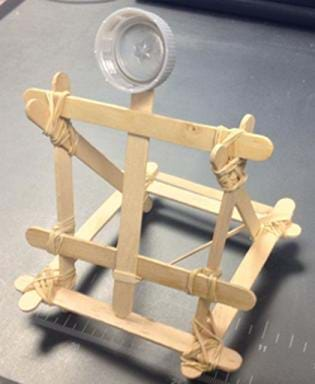Quick Look
Grade Level: Middle school
Time Required: 45 minutes
Expendable Cost: US $0.50
Group Size: 3
Subject Areas: Algebra, Physical Science, Physics
Introduction
Bolded words are vocabulary and concepts to highlight with students during the activity.
What is potential energy? Potential energy is energy that is stored and can be turned into kinetic energy, the energy of motion. A ball held at some height above the ground has potential energy caused by gravity; when the ball is dropped, it falls at an increasing rate, increasing its kinetic energy while decreasing its potential energy. The potential energy is converted to kinetic energy during the fall. On the other hand, a ball resting on the level ground has no gravitational potential energy; it has no potential for movement unless acted on by an outside force (other than gravity). Potential energy can come from gravity, but also from elasticity, such as a rubber band. When a rubber band is stretched, its potential energy increases; when it is released, it snaps back (kinetic energy), and its potential energy returns to zero. 
Engineers must understand both potential and kinetic energy. A simple example is the design of a roller coaster—a project that involves both mechanical and civil engineers. When the roller coaster reaches the highest point (before the biggest drop), the cars must have enough potential energy to power them for the rest of the ride. This is done by raising the cars to a great height, increasing their gravitational potential energy. Then, the potential energy of the cars is converted into enough kinetic energy to keep them in motion for the length of the track.
Supplies
Each group needs:
- 15 craft sticks
- 5 Skittles® (small candy pieces)
- 20 rubber bands
- 2 sheets of paper
- bottle cap
- 6" (~15 cm) length of masking tape
- hot glue (shared)
Subscribe
Get the inside scoop on all things TeachEngineering such as new site features, curriculum updates, video releases, and more by signing up for our newsletter!Procedure
Procedures Overview
Students work in teams of three. First, they design their catapults and get them checked by the instructor. Then, groups construct their catapults, and use them to launch candy pieces at a target.
Designing and Building the Catapult
Note: Do not hand out any supplies to groups until their designs are approved; and do not hand out the candies until catapult construction is complete. Also, only permit the instructors to handle and use the hot glue guns. 
- Show students the supplies: inform them that they can use up to 15 craft sticks and 20 rubber bands, but they only get one bottle cap. Let students know that they are only allowed to use the hot glue to attach the cap to the catapult, not to connect any sticks.
- Instruct groups to draw out their catapult designs on paper, thinking about the distance they need to launch the candy pieces, how the catapult will hold the candy piece, the cability to adjust the launch distance, etc.
- Groups bring their designs to the instructor who "signs off" on it and provides design advice if necessary.
- Tell groups to bring their bottle caps to the instructor when they are ready to have them glued on, indicating precisely where they want the cap glued.
- When a group is ready to test its catapult, hand out ~5 Skittles to the team. Remind students not to eat their projectiles.
- Instruct students to draw a target on a sheet of paper, and use masking tape to attach it to a chair 5-10 feet from the launch point.
- Have students launch their candies at the target to see if they can hit it consistently. Encourage groups to make changes to improve their designs.
- Have each team present its design to the class, explaining the design and any post-testing changes they made.
Wrap Up - Thought Questions
- What parts of the design can be changed to increase/decrease the distance the Skittle flies?
- What can be changed about the lever arm that would make the candy fly a different distance?
- At what part of the launch did the Skittle have the most potential energy? When did the Skittle have the most kinetic energy?
- How did you design your catapult to increase potential energy of the Skittle? Why would you want to increase the potential energy?
More Curriculum Like This

Students explore the physics exploited by engineers in designing today's roller coasters, including potential and kinetic energy, friction and gravity. During the associated activity, students design, build and analyze model roller coasters they make using foam tubing and marbles (as the cars).

Students are introduced to both potential energy and kinetic energy as forms of mechanical energy. A hands-on activity demonstrates how potential energy can change into kinetic energy by swinging a pendulum, illustrating the concept of conservation of energy.

Students learn about catapults, including the science and math concepts behind them, as they prepare for the associated activity in which they design, build and test their own catapults. They learn about force, accuracy, precision and angles.
Copyright
© 2013 by Regents of the University of ColoradoLast modified: May 11, 2022








User Comments & Tips